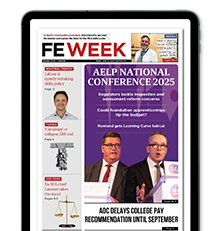The next government should phase in a “flex and match” skills levy that allows employers to spend part of their money on non-apprenticeship training – but only if they invest as much in apprenticeships for young people, a new report proposes.
The Learning and Work Institute has put forward a detailed blueprint of how the current apprenticeship levy, which the research body claims has been “counterproductive” to increasing apprentice numbers, could be reformed.
It comes amid vague plans from Labour to introduce a “growth and skills” levy that allows up to 50 per cent of employer payments to be spent on non-apprenticeship training.
The Conservatives have meanwhile committed to retaining the apprenticeship levy in its current form if the party wins next month’s election.
L&W chief executive Stephen Evans (pictured), who wrote the report which has been shared exclusively with FE Week, claims his proposal would allow the next government to flex the levy gradually while protecting the apprenticeship budget in real terms and encouraging more investment in young people.
A flex, match and cap skills levy…
Under the plans, the apprenticeship levy would be broadened, with greater flex for employers to use their funds for training outside of apprenticeships matched to a maximum of the amount they spend on apprenticeships for 16 to 24-year-olds and capped at up to 50 per cent of the levy.
The changes would be introduced over time to identify and deal with unintended consequences as they arise, with up to 15 per cent of levy funds able to be spent on other qualifications in years one to three, 30 per cent in years four to six, and 50 per cent thereafter.
For example, a firm paying £2 million as a skills levy could in time spend up to
£1 million on approved training outside apprenticeships, but only if it had spent
£1 million on apprenticeships for young people.
This training outside of apprenticeships would include functional literacy, numeracy and digital skills and other training from an approved list up to level 5 that is reassessed each year, helping to support national priorities such as net zero, housing and productivity.
…at no extra cost
The apprenticeship levy is a 0.5 per cent payroll tax on businesses with annualised wage bills of £3 million or more. In England, levy-paying employers spend an average of 50 per cent of their payments on apprenticeships. The remainder is kept by the Treasury and helps to fund apprenticeships for smaller firms.
In 2023-24 the levy raised £3.9 billion, but only around £3.2 billion was spent on apprenticeships by the government, including distributions to Scotland, Wales and Northern Ireland.
L&W’s report said natural growth in the amount raised by the apprenticeship levy is likely to mean the headroom grows to allow its proposed skills levy to happen.
Based on the Office for Budget Responsibility’s (OBR) forecasts, and assuming the amount allocated to the Department for Education for apprenticeships rises in line with inflation from 2024-25 onwards, the government will be raising £1.1 billion more from the levy than it spends on apprenticeships and gives to devolved administrations by 2028-29, L&W said.
The report claimed that maintaining this margin at the estimated 2023-24 level (over £700 million) would mean a “spare” £412 million by 2028-29.
SMEs won’t be left out
Evans told FE Week that his proposed skills levy should continue the same trend of levy-payers spending around half of their funds in total, with the remainder going towards funding apprenticeships in small and medium-sized employers who do not pay the levy.
He said £200 million of the “spare” funding that would be generated each year could then be used by SMEs to invest in training outside apprenticeships. This would be in addition to current policy where the government covers 95 per cent of small firms’ apprenticeship training costs, and 100 per cent where the apprentice is aged 22 or less.
More apprenticeships for young people?
Apprenticeship numbers are down 34 per cent since 2015-16, before the apprenticeship levy and other reforms were introduced in 2017, and down 40 per cent for under 19s. Only one in two apprentices completes their apprenticeship.
L&W has also found that one in four apprentices at levy-paying firms is aged over 25 and studying at higher education level.
The report said it was “likely” that the proposed changes would lead to levy paying employers reducing some of their higher apprenticeships for existing employees and instead funding qualifications for them, while increasing funding on apprenticeships for young people.
Evans said: “We need a new skills levy that gives more flex for employers to invest in training that makes a difference, but demands they increase apprenticeships for young people to unlock that flexibility. We can do that while protecting the apprenticeship budget for England in real terms.
“Coupled with a laser-like focus on improving quality and increasing poor apprenticeship completion rates, the next government has the chance to revitalise apprenticeships and training opportunities.”

















Your thoughts